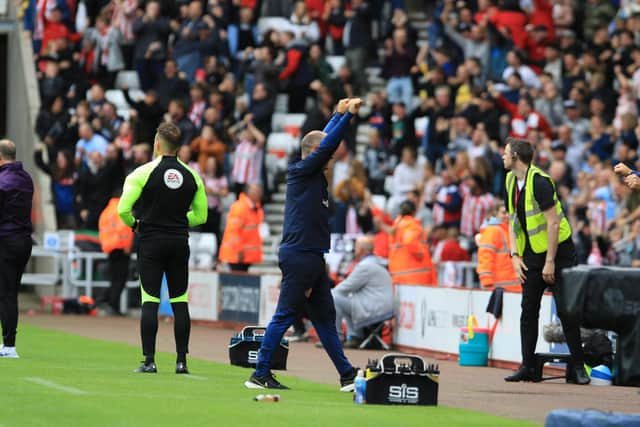Alex Neil gives this fascinating insight on the big tactical change he's made at Sunderland this summer
and live on Freeview channel 276
They've scored, they've won, and done both away from home.
If there was one frustration in the aftermath of the game at Ashton Gate (well two if you include Nathan Broadhead's decision to join Wigan) it was that two sloppy goals were gifted up to the opposition.
Neil is also very clear, though, that some defensive vulnerability is to be expected this season. Whereas his focus on arriving at the club last season was to fix defensive vulnerabilities, this summer he has been far more focused on the other end of the pitch.


Advertisement
Hide AdAdvertisement
Hide AdHigh-scoring games and chances for both sides are not just anticipated but welcomed.
Shifting the dial of his side to a more front-foot approach is what he believes is the best path to safety and consolidation this season.
"We want to keep clean sheets but more importantly, I think the difficulty we've got at the moment is, how I see us is that we're at our best when we're attacking.
"At the moment, I don't want to take that attacking element and dampen it down any. I believe just now that's the best chance of us winning games, and for that to happen you then sometimes leave yourselves a little vulnerable at the back.
Advertisement
Hide AdAdvertisement
Hide Ad"I don't want to turn the dial too much in terms 'we'll secure here' because then I think we'll carry less of a threat at the top end of the pitch.
"And at the moment, I think the way we've approached it has allowed us to get four points on the board.
"Yeah we absolutely want to brush up on any silly defensive errors, but our attacking intent is something I expect to remain," he added.
"What I always felt when we were in League One was, if I can secure the back line then I've got players who will always win me games. That's how I approached it, because I knew that if we fixed that [the defence] we would go and win a lot of matches.
Advertisement
Hide AdAdvertisement
Hide Ad"What I think is that at this level, it's much harder to create chances, get opportunities and score goals.
"So our focus predominantly has been on being more aggressive, and having more attacking talent. I don't think you can rely on just fixing the backline, and letting the rest happen for itself. I think the level is too good now for that to be the case.
"I think we've shown, against Coventry albeit we had a good defensive shape, our attacking intent was clear for everyone to see and certainly against Bristol City, it was a very open game.
"Now I could dial it back it a bit, be more conservative and keep the game at arm's length to an extent, but I think I'm then not utilising the key strengths of the players we've got.
Advertisement
Hide AdAdvertisement
Hide Ad"What you don't want to do is get our front players being more defensively structured, but then losing their key attributes."
Neil will face a dilemma when QPR visit the Stadium of Light on Saturday as they are one of the few teams in the division to play with a back four in defence.
Neil himself much prefers that system, but has predominantly played with a back three since arriving on Wearside. It has continued at the start of the Championship season even though he regularly experimented with 4-2-3-1 in the build up.
As the head coach explained on Friday morning, that is in part because of his own personnel and in part because 3-5-2 has become the dominant shape across the second tier.
Advertisement
Hide AdAdvertisement
Hide AdCertainly right now, it's a system that gives him the tantalising prospect of pairing Ross Stewart and Ellis Simms together without leaving his side too open.
"I think that, football is a numbers game and that's the way I would describe it," he explained.
"You attack with a certain amount of players and you defend with a certain amount of players. Now if you play with a back four, normally what happens is if you attack down one side the other full back will tuck himself round and you basically end up with a back four.
"The difficulty you've got is sometimes both your full backs will want to go [forward] at the same time. That means you're only defending with two, and even if you've got two sitting midfield players you can get caught with them beyond the ball.
Advertisement
Hide AdAdvertisement
Hide Ad"I think the back three covers the width of the box more and that allows the other lads not to be overly concerned about getting back. You've always got three behind the ball.
"Arguably, it gives teams a better balance between attack and defence. I'm a big advocate of 4-3-3 and have played it for large spells of my managerial career, but I've enjoyed trying to find solutions for a 3-5-2.
"I'd not used it much before I came here but it's been what I've used predominantly, and that's been because of the personnel we've got.
"I think what it allows us to do is let Jack Clarke off the leash a little bit, Goochy as well. It also allows to get two strikers at the top end of the pitch just now and certainly if you look at the last game....
Advertisement
Hide AdAdvertisement
Hide Ad"But listen, I'd have no qualms and no issues playing a different shape. We did it in the play-offs, when we'd played with a back three and switched for the two most important games of the season."
Neil has warned of ups and downs this season, but it looks like the open games in the first fortnight of the season are here to stay.